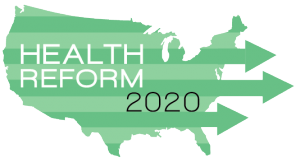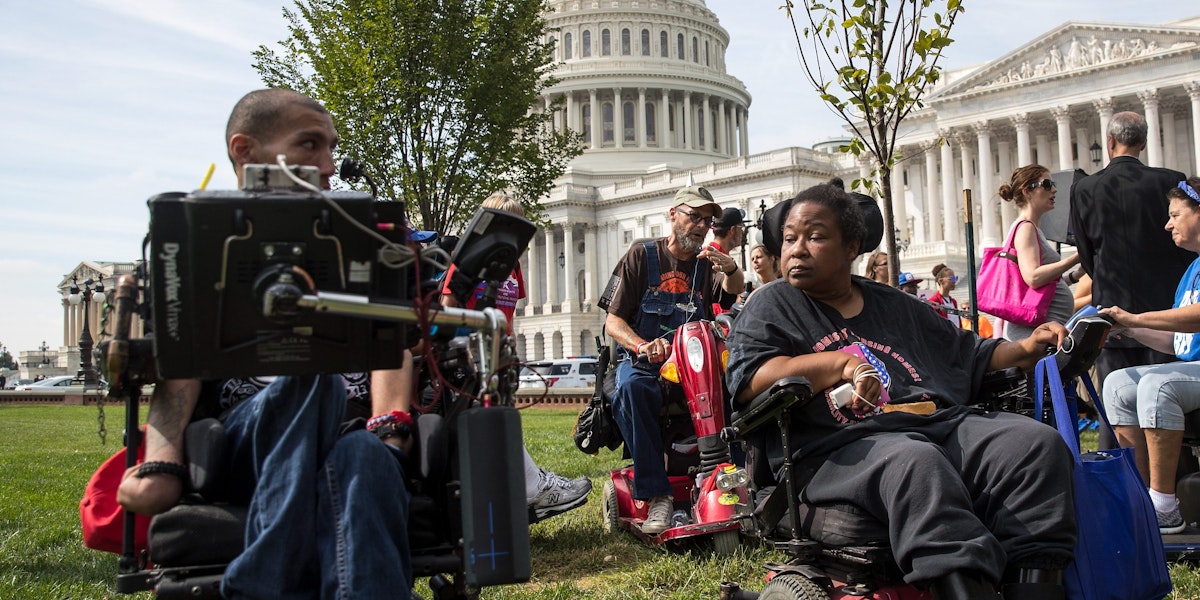Imagine that you attend a country music concert or a quiet Texas church service, or are simply stopped at a local red light. In a flash, you are shot in the neck by a mass murderer. You wake up two days later in a hospital bed, a C45 quadriplegic. You will require home health-care aides, a $45,000 customized sip-and-puff electronic wheelchair, long-term services, and supports for the rest of your life.
Such atrocities highlight massive defects in American gun policy. That part is obvious. Less obvious is how these atrocities also highlight massive defects in our health policies. Many of those disabled by gunfire will face a blizzard of medical bills and struggle to get needed services, rejoin the workforce, or ever resume a normal economic life. The next generation of health-care reform needs to address these problems more effectively.
The Affordable Care Act made things better, particularly in Medicaid expansion states. Many of the 200 people shot last October in Las Vegas will be well treated through private insurance or Medicaid. Fewer people will be denied care because they were uninsured, had no coverage for essential benefits, or required costly surgeries that blew out their insurer’s annual cap. We won’t have as many gunshot wound victims walking around with helmets covering missing skull fragments or with colostomy bags because they couldn’t find a surgeon to close their abdominal wounds, as there were in Chicago and Detroit before the Medicaid expansion.
The ACA also included a host of smaller measures designed to help states improve disability services, including demonstration projects and Medicaid waivers designed to offer individuals viable alternatives to institutional care. The law reauthorized and expanded the Money Follows the Person (MFP) demonstration to help people living with disabilities transition from institutions to the general community. The Community First Choice option (CFCO) and the Balancing Incentive Program increased the pertinent Medicaid match for states that provide new or expanded home and community-based services.
For these reasons and more, the ACA was the greatest advance in decades for the disability community, and Republican repeal-and-replace proposals were the greatest corresponding threat. Those proposals went beyond mere repeal to block-grant and significantly cut Medicaid services critical to people with disabilities. So across red states and blue, millions of Americans mobilized to defend Medicaid and the ACA. Disability advocacy groups played a central role in this fight, most dramatically in nationally televised sit-ins and arrests outside the office of Senate Majority Leader Mitch McConnell. As Andy Slavitt, the former administrator of the federal Centers for Medicare and Medicaid Services, told me: “The voice of groups like ADAPT and a number of others was essential to holding off ACA repeal this year, and millions of Americans should be grateful to them for that.”
Despite its accomplishments defending ACA, the disability community has been marginalized in current Democratic Party debate over what comes next, whether a new public option, single-payer health plan, or other alternatives.
That’s a big blind spot. Consider what will happen to Las Vegas gunshot victims who will require long-term services and supports. Many will require some combination of Medicare, Medicaid, Supplemental Security Income (SSI), and Social Security Disability Insurance (SSDI). Many of their lives will be diminished by our nation’s needlessly fragmented and inhumane patchworks of supports for disabled Americans.
The details will differ for each person. These will depend on the state in which she lives, the services she needs, her years in the paid workforce, and whether she has the resources, education, and social connections to get the right legal representation. If that’s you, one thing will be the same no matter where you are: You will face complicated bureaucratic barriers, perhaps waiting lists for key services, and income and asset limits that will limit your resources for other needs. The gunshot victims from mass shootings are in good company. Americans who become disabled from car wrecks and wrestling injuries, cancer, intellectual disabilities, or dementia generally face similar predicaments.
If you’ve worked long enough, you might qualify for SSDI, the federal disability insurance program, which provides a reasonable monthly income if you’ve had a strong earnings history, though the average is more like $1,200. SSDI imposes big penalties for continued paid work. Its accompanying Medicare coverage leaves big gaps, too. Eligibility determination can be an arduous process, depending on the severity of your condition. After you have been approved for SSDI benefits, you also face a two-year waiting period for Medicare before your health coverage kicks in.

Particularly if you are young or low-income, you’ll likely end up on SSI. You will receive a smaller monthly check, around $735 if your state doesn’t boost the federal benefit. You will then discover that you’re no longer allowed to possess more than $2,000 in countable financial assets. In principle, you can own a home and a primary vehicle. No one will take your wedding ring or your work tools. That’s usually about it. No more retirement savings. No strategic reserve in case your roof leaks or the furnace blows.
I simplify a bit. With the right lawyers and personal circumstances, a special needs trust may help. If you were shot one week before your 26th birthday, you and your loved ones can contribute up to $14,000 every year to something called an ABLE account, which can be used to procure many basic necessities to work around the $2,000 asset limit. If you turned 26 two weeks before being injured, you’re ineligible. If you do have an ABLE account but you and your family lack funds to stoke that account, you’re out of luck, too.
On SSI, you’ll receive Medicaid rather than Medicare. That has its advantages. Medicaid’s benefit package is richer. You won’t face SSDI’s two-year waiting period. If you are severely disabled but can still work, SSI ironically provides better pathways to return to work and retain your health services. To further complicate things, some people receive both SSDI and SSI, both Medicare and Medicaid, depending on their circumstances.
American disability policy is a costly, fragile, and complicated mess.
In fiscal year 2014, Medicaid spent $186 billion on services for individuals who qualify on the basis of disability. That’s the costliest overall category of Medicaid recipients, and it actually understates things, since people living with disabilities are well represented within every other qualifying category of Medicaid recipients.
Although most Medicare recipients are seniors, Medicare covers millions of Americans younger than 65, particularly those who live with disabilities. Under-65 recipients are, on average, about one-third more costly than the Medicare average. Much of the difference appears to arise from higher prescription drug costs for people with disabilities. Young recipients with disabilities are also more likely than seniors (23 percent versus 8 percent) to report that they were unable to see a doctor to address a health problem. When this happens, it’s usually for financial reasons. Such financial barriers reflect Medicare’s deductibles and copayments, which can be punishing.
Almost exactly one-third of expenditures for both Medicare and Medicaid finance services are for “dual-eligibles,” who receive assistance from both programs. My brother-in-law Vincent is one of these recipients. Living with an intellectual disability known as fragile X syndrome, Vincent receives Medicare and survival benefits based on his father’s work history. He also receives Medicaid, which finances most of the services he receives.
Millions of people benefit from dual eligibility. Medicare helps recipients avoid access barriers associated with Medicaid’s low provider reimbursement. Medicaid provides a tapestry of disability services that Medicare doesn’t cover. It also plugs the holes left by Medicare’s painful cost-sharing.
This divided structure can be administratively incoherent. States and the federal government each face incentives to foist costs on the other level of government. The need to coordinate Medicare with 51 separate Medicaid programs hinders efforts to craft properly integrated care arrangements for some patients with the most complex problems.
Dual eligibility raises, yet again, uncomfortable questions about the minimum standards America should tolerate across the states. States such as Massachusetts and Minnesota provide excellent Medicaid services. Others, including my own state of Illinois, fall far short of that standard. Under Barack Obama, the Justice Department actively monitored and sued states that failed to meet basic needs, including people’s right to live with proper supports in their own communities. Under Donald Trump, the future of such oversight is now in doubt.
Then there is the precarious private insurance market for disability services and long-term care. As of 2014, only 7.2 million Americans held long-term care policies, and only about 14 percent of Americans over the age of 60 had that coverage. This market has deteriorated in recent years, with major insurers exiting the market, and with premiums sharply increasing for new policies sold to people over the age of 55. Sales of individual policies are far below levels of even 15 years ago.
It’s hard to see that situation improving, since the problems stem from the fundamental nature of the market. Consumers have no real way to evaluate the quality of the coverage they buy to protect themselves against serious risks. Many people mistakenly believe that Medicare covers long-term care services. In the absence of an individual mandate, insurers have their worries, too. Consumers know more about their health and personal risks than insurers do, and the proliferation of online genetic services on the model of 23andMe may further encourage people at high risk of long-term care to buy coverage and people at low risk not to buy it. Insurance doesn’t work under those conditions.

Read all of the articles in the Health Reform 2020 series, co-produced by The Century Foundation and The American Prospect.
In addition, these markets suffer deep structural challenges. Most insurance markets, say automobile collision insurance, protect individuals against immediate risks, like the risk of an accident over the next year. Disability insurance seeks to protect people against risks that might play out over 20 years. Many factors could intervene over that long timespan to alter individuals’ risks. Every year, there are hundreds of thousands of car accidents. Any one driver’s accident risk is pretty well understood. Because the risk comes in the form of so many independent discrete events, auto insurance is a stable business.
As Harvard economist David Cutler has pointed out, the market for long-term care is fundamentally different, and thus fundamentally less stable. Many of the most important uncertainties are not tied to specific individuals. They are instead systemic, potential tidal waves that could smash the entire market. Perhaps costly new dementia treatments will emerge that extend patients’ lives without improving cognitive function. Perhaps autonomous vehicle technologies will create new opportunities for mobility for individuals with spinal cord injury. Perhaps changes to Medicaid will make such policies less valuable to consumers. Then there is the challenge of predicting medical inflation and prevailing interest rates. Insurers face enormous uncertainties in determining fair prices, and consumers realistically worry that insurers will get the price wrong and might not even be in business when it comes time to submit a claim.
The ACA included one worthy but ill-fated effort called the CLASS Act that sought to address these challenges. Under this voluntary workplace-based insurance program, individuals could have bought a long-term care policy financed by community-rated monthly premiums that would have helped cover the cost of home health aides, a wheelchair ramp, or other supports to live an independent life. But the law included no public subsidies to attract low-risk consumers and no mandate to require people to enroll. Although those problems might have been fixed, CLASS got caught in the partisan crossfire and was never implemented.
Like the ignominious reversal of the Medicare Catastrophic Coverage Act of 1988—repealed the year after it was passed—CLASS’s demise highlighted the tensions between the disability community and advocates of expanded health insurance coverage. These tensions are now submerged, as the two groups have cooperated beautifully in defense of the ACA and Medicaid. Yet their priorities and political approaches are different. When Congress was debating the ACA, key proponents of the law quietly opposed CLASS, regarding it as unworkable, sometimes grumbling that CLASS was an embarrassing budget gimmick. Later, neither the advocacy groups nor the Obama administration expended much political capital to defend CLASS after analysts raised doubts about its financial feasibility.
Single-payer and public-option advocates seek straightforward, economical coverage expansions that can—ideally—-be presented in a simple “Medicare for all” bill. Although disability advocates want to see coverage extended, they need other things, too, including additional funding for disability services and stronger oversight of existing programs. Universal coverage advocates must decide how much they wish to become enmeshed in these daunting matters. Senator Bernie Sanders’s plan includes valuable provisions to improve disability services. Perhaps most important, it would address excessive patient cost-sharing, so punishing to people with disabilities. It would also eliminate SSDI’s two-year waiting period for Medicare benefits. The plan’s expanded package of services, such as dental care, would also be valuable for individuals with disabilities.
A number of health policy experts have suggested federalizing the costs now borne by the states for people who are eligible for both Medicaid and Medicare. That would allow a more unified payment system and relieve states of about one-third of their Medicaid costs. In designing his own legislation, Senator Sanders made a more restrained choice, which may surprise some observers of the single-payer debate. While folding Medicaid’s general insurance coverage into Medicare, the Sanders bill would leave Medicaid-funded disability services as they are, outside the scope of its proposed Medicare-for-all plan. Although Sanders may encounter criticism for this departure from a comprehensive single-payer vision, this choice seems sensible. It not only retains states’ financial contributions for disability services but avoids trying to rewire the different systems the states have established for dealing with disability issues.
States have spent 50 years weaving Medicaid into nursing home care, school-based services, and a complicated array of other programs adopted under federal waivers and in response to litigation. Creating a single national disability system would require legislation that is probably more complicated than the ACA was, with all the attendant wrangling, winners and losers, and legislative screw-ups that would inevitably occur.
From a political perspective, Democrats are probably wise not to make disability the centerpiece of their national health reform efforts. But they could make significant progress through measures of three types: 1) incremental improvements to current policies; 2) structuring public options so as to address disability problems; and 3) long-term reforms, demonstration projects, and programs for the decades to come.
Incremental improvements. A few obvious measures could be taken that would really matter. SSDI’s two-year Medicare waiting period is a relic from another time. It should simply be abolished.
Congress should also expand the alphabet soup of ACA provisions and Medicaid waiver efforts designed to allow Americans with disabilities to live less-restricted lives in their own communities. For example, it ought to increase MFP’s modest current budget, which prevents the program from serving more than a tiny fraction of eligible clients.
Many of these programs enjoy quiet bipartisan support across different levels of government. Disability is less disfigured by partisan polarization than are other areas of American public policy. Such matters have the additional advantage that they are generally too boring and complicated to make the front page.
Two arbitrary restrictions—the limit on personal assets and age threshold for ABLE accounts—ought to be eliminated. I’ve never met a Republican or Democrat who believes that the $2,000 Medicaid/SSI cap made sense. In 1972, the cap on personal assets was $1,500, equivalent to $8,800 today. For reasons that baffle me, it’s been stuck at $2,000 since 1989. I would eliminate the cap. After all, the ACA Medicaid expansion does not include an asset test. If that’s politically impossible, raising the cap to (say) $20,000, with annual cost of living increases, would allow SSI recipients to live more normal lives, while deterring truly affluent people from signing up.
Raising the age threshold for ABLE accounts would also help. I see no compelling reason these accounts should be restricted to those who become disabled before age 26. The federal government might even consider making modest contributions to such accounts. At every age, people with disabilities need money to plan and live.
Beefing up the Social Security Administration’s organizational capacities would also help. Faster eligibility determination is especially important for rejected applicants. The sooner these applicants get the bad news, the more likely they are to obtain gainful employment.
Marketplaces and the public option. Disability-related provisions could also be strengthened on the state marketplaces and on new public option proposals. Policymakers need to understand the likely implications of a public option that might disproportionately attract people who experience some level of disability. They also face a basic strategic choice: whether to encourage and welcome such differential take-up, which would increase direct program costs while helping to stabilize and implicitly subsidize private marketplace plans.
Prospect co-editor Paul Starr’s “Midlife Medicare” proposal, for example, is mostly silent on disability matters. Underneath, however, Starr and other public option proponents expect and may even hope that many individuals with disabilities will obtain some form of public rather than private marketplace coverage. Starr would eliminate SSDI’s two-year Medicare waiting period to help stabilize the marketplace risk pool. He would not, however, enrich the package of Medicare disability-related benefits beyond what is offered in Medicare Advantage plans.
Disability advocate Joe Entwisle suggests that marketplace plans could include as essential health benefits a package of rehabilitation, durable medical equipment, and habilitative services pertinent to disabilities. The most ambitious approach would require this of all public and private plans. I wouldn’t go that far, since this would require deeper rewiring of a private marketplace which is already stressed by competitive and policy uncertainties.
Another possibility would be to openly design the public option to provide more attractive disability-related provisions integrated with Medicaid than would be available in private coverage. This would require a complex structure of additional public subsidies, since this arrangement would draw the most costly consumers into the public option. However, it would not require intricate rewiring of private marketplace coverage.
Such measures would increase the public option’s on-budget costs. This is not, in itself, a problem. It would relieve financial pressures on the ACA marketplaces, providing de facto reinsurance to address the most costly beneficiaries. Such a policy would help constrain health insurance premiums for other marketplace participants, while providing secure coverage for recipients who truly require disability services.
What about the decades ahead? America faces a looming long-term care challenge we have yet to acknowledge, let alone address. It seems to me that the immediate task is to take useful steps that modestly help to address these challenges, and not allow the health policy debate to become dominated by these issues until we can solidify the gains brought by ACA.
Looking over the next hill, one might try to support market-based efforts to support long-term care. One possibility is a publicly subsidized but largely private insurance market, in which government provides some sort of backstop to cover catastrophic care costs. Such an approach commands some academic support across ideological lines.
Another possibility would be to set the stage for some actuarially solid modification of CLASS. The federal government (or individual states) might require everyone to buy long-term care insurance, with a well-articulated essential benefit package, a strong individual mandate, and subsidies to keep premiums low and to keep healthy low-income consumers comfortably in the risk pool. Yes, these plans could be sold and regulated on the ACA marketplaces.
Ten years ago, I would have supported such partnerships between the private marketplace and government. Had the ACA marketplaces been a smashing success that now commands bipartisan support, I would support that today. After witnessing the ACA fight, I am less enthusiastic about ideologically moderate but politically fragile and organizationally complex approaches. Republicans have made the individual mandate politically toxic. For the moment, anyway, their scorched-earth opposition to everything ACA has discredited the very idea of pragmatic bipartisan compromises to health policy within the Democratic Party.
I suspect some straightforward Medicaid expansion would prove more popular and politically durable. So I would eventually abolish Medicaid’s spend-down requirements and asset tests. A society that seems so ambivalent about imposing a “death tax” on $11 million estates might someday consider the wisdom of imposing more brutal provisions on men and women who contract dementia, spinal cord injuries, or cancer, and thus require long-term care.
All that’s for a future fight.
For now, though, first things first. The most important task is to defend and build on the ACA. The disability community won’t take the starring role in the next round of health reform. They still deserve a place onstage. As Henry Aaron of the Brookings Institution has said to me, the immediate challenges of disability policy require the granular incremental skills of a Henry Waxman, the longtime Democratic health-policy champion in the House of Representatives. We must craft disability-related additions to Democratic proposals, and begin to build the platform for future ambitious reforms.
We all know more is coming, someday, when our nation is finally ready to face the looming financial and human challenges of a rapidly aging society.
 This article was published as part of a special report on health care reform, co-produced with The American Prospect.
This article was published as part of a special report on health care reform, co-produced with The American Prospect.










